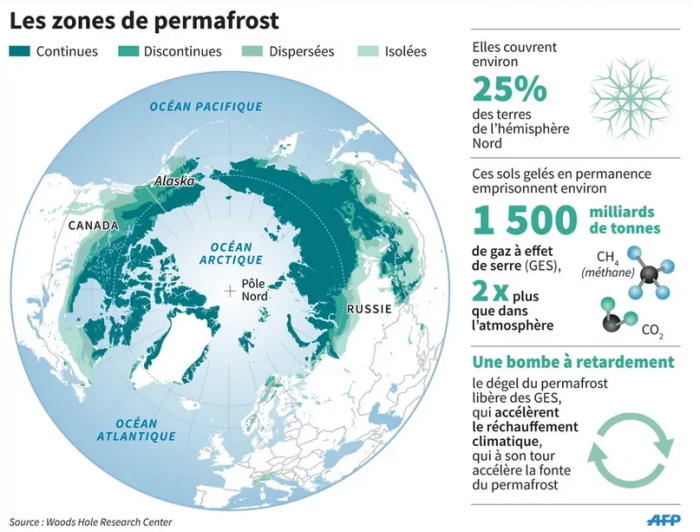
Although the Arctic is traditionally defined as a cold region, it is currently warming faster than any other area on Earth. A recent study highlights an alarming acceleration in this trend, particularly linked to carbon dioxide emissions.
Arctic Tundra Now a Source of CO2
The NOAA (National Oceanic and Atmospheric Administration) has released a concerning report indicating that the North Pole has become a net emitter of CO2. In other words, the Arctic now releases more carbon dioxide than it stores. As illustrated in the map below, vast areas (in purple) are now emitting CO2, while the regions that traditionally absorbed carbon can no longer offset these emissions.
This shift represents a significant turning point, as the Arctic’s capacity to act as a carbon sink diminishes, further amplifying the global climate crisis.

Zones Absorbing (Green) and Emitting (Purple) CO2 in the Arctic – NOAA
This alarming trend is driven by several key factors. According to the NOAA, the melting of permafrost—permanently frozen soil that holds vast amounts of greenhouse gases—is accelerating, particularly along the Arctic coastlines.
One notable hotspot is the Beaufort Sea, north of Alaska, where coastal tundra is eroding at an increasing rate. As the permafrost becomes exposed, its thawing has significantly intensified in recent years, releasing both CO2 and methane into the atmosphere.
These emissions from thawing permafrost contribute to a dangerous feedback loop, further amplifying the pace of global warming and heightening the urgency for climate action.

Tundra Erosion Exposing Permafrost in Alaska’s Beaufort Sea – Craig McCaa via NOAA
Additionally, rising global temperatures are driving increased vegetation growth in Arctic regions. While this may initially seem like a positive development, it comes with significant downsides.
The expansion of vegetation heightens the risk of wildfires, as larger areas become susceptible to burning. In recent years, the Arctic has experienced a dramatic surge in wildfires, which have released massive amounts of CO2 into the atmosphere, further compounding the effects of climate change.
These fires, combined with permafrost thaw, create a devastating cycle that accelerates the warming of this fragile ecosystem.

Surge in Wildfires Since 2019 in Siberia – Photo by Greenpeace
The Arctic Is Warming Far Faster Than the Rest of the World
It is now a well-established fact: the North Pole is the fastest-warming region on Earth. This trend has intensified significantly over the past decade. In the Arctic, the nine hottest years on record are the past nine years.
Certain parts of the Arctic are warming four times faster than the global average. In Siberia, some areas are experiencing an astonishing rise in average temperatures—up to 1.5°C per decade. These alarming figures point to a vicious cycle, with permafrost thaw and increasingly frequent wildfires driving the Arctic toward an irreversible tipping point.

Temperature and Ice Concentration Trends per Decade in the Arctic – via Nature
While climate change affects the entire planet, all models agree on the continuation of the current trend in the Arctic. While global average temperatures are projected to rise by +2 to +3°C by the end of the century, simulations predict an increase of +5 to +7°C in the high latitudes of the Northern Hemisphere.
Such a dramatic rise threatens to disrupt entire ecosystems, placing the prospect of climate tipping points firmly on the global agenda. These changes could have far-reaching consequences, not only for the Arctic but for the planet as a whole.

Projected Temperature Increase Between the Beginning and End of the 21st Century – via ResearchGate.net
Permafrost Thaw: A Ticking Time Bomb
Permafrost and its future are major climate challenges. These permanently frozen soils cover around 25% of the land in the Northern Hemisphere at high latitudes. It is well known that permafrost contains vast quantities of CO2 and methane, potent greenhouse gases.
Estimates suggest that nearly 1,500 billion tons of greenhouse gases are trapped in these frozen soils. As the Arctic warms, significant amounts of these gases could be released into the atmosphere. This process could trigger a dangerous feedback loop, potentially leading to an uncontrollable climate runaway scenario.

Permafrost Zones in the Northern Hemisphere – Infographic by AFP
In addition to its climate implications, permafrost thaw also poses significant public health risks. Many ancient viruses have been trapped in the frozen soils for thousands of years. As the permafrost melts, these viruses may be released into the environment, potentially exposing humans and animals to diseases for which they have no natural immunity.
In 2016, an outbreak of anthrax (a disease that had disappeared over 70 years ago) occurred in Siberia after the thawing of a reindeer carcass that had died from anthrax in the last century. This allowed the bacteria to spread, infecting livestock and humans. The risk now is the potential release of other, more deadly viruses or bacteria, which could have devastating consequences in the future.

Reindeer Dead from Anthrax Contamination in Siberia – Russian TV
Source: Meteo Paris


